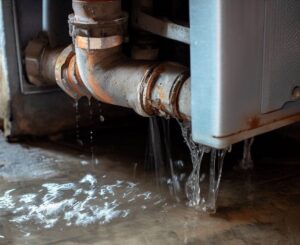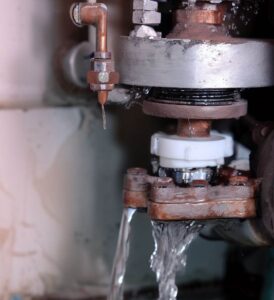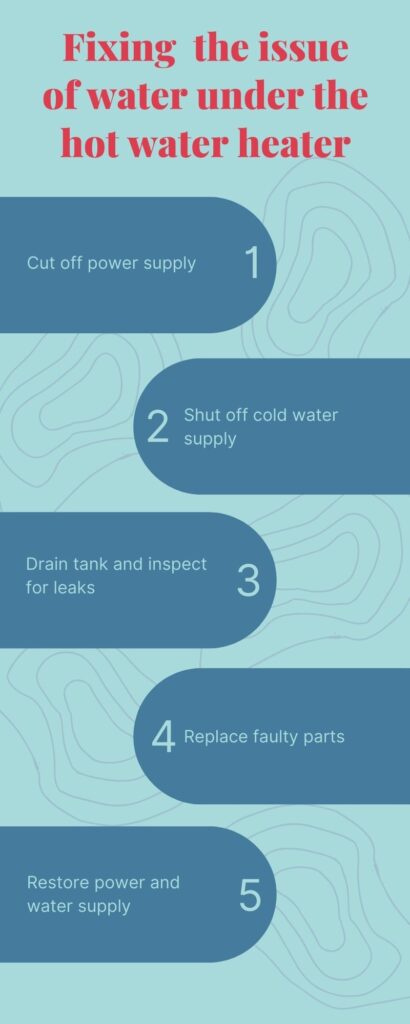Table of Contents
Water underneath your hot water heater? It might be a cause for concern. Let’s look at what could be causing it and potential solutions.
- First, check if the pan under your unit is full and if there are any leaks from the bottom. This might be an indication of a damaged tank or problem with the valves or pipes.
- Excessive pressure inside the tank could be the culprit. High pressure can cause leakage from the relief valve, leading to pooling. Or, it could be a crack in the internal tank letting hot water escape and collect.
- If you have a gas powered one, check for gas leaks too. A gas leak combined with water leakage creates a safety risk and should be dealt with by a pro.

Regular maintenance is the key to preventing potential problems. Flush out sediment and replace worn-out parts on a regular basis to extend the lifespan of your unit and avoid future issues.
If it’s just a small leak, tightening any loose connections with a pipe wrench may help. But, it’s best to get a professional plumber for proper repairs.
Key Takeaways
- Water under a hot water heater can be a sign of a leak or a malfunctioning component. It is important to address this issue promptly to prevent further damage and potential safety hazards.
- One possible cause of water under a hot water heater is a leaking tank. Over time, the tank can develop cracks or corrosion, leading to water leakage. In such cases, it is recommended to replace the tank to prevent further damage.
- Another common cause of water under a hot water heater is a faulty temperature and pressure relief valve. This valve is designed to release excess pressure and prevent the tank from exploding. If the valve is malfunctioning, it can cause water to leak from the tank. Replacing the valve is usually the solution in such cases.
- A leaking drain valve can also be a reason for water under a hot water heater. This valve is used to drain the tank for maintenance or repairs. If the valve is not tightly closed or is damaged, it can cause water to leak. Tightening or replacing the drain valve can resolve this issue.
- Condensation can also lead to water under a hot water heater. This usually occurs in humid environments or when the temperature of the water inside the tank is significantly higher than the surrounding air. Insulating the tank and pipes can help reduce condensation and prevent water accumulation.
- Regular maintenance and inspections are crucial to prevent water leakage under a hot water heater. Checking for any signs of leaks, corrosion, or malfunctioning components can help identify and address issues before they escalate.
- If you are unsure about the cause of water under your hot water heater or if you are not comfortable handling the repairs yourself, it is recommended to contact a professional plumber. They have the expertise and tools to diagnose and fix the issue effectively and safely.
The issue of water under the hot water heater
Finding water under your hot water heater is like discovering a waterpark in your basement, just without the fun slides. It can raise questions and cause concern. To understand why it’s happening and to address the issue, it’s important to know what’s causing it.
It could be a leak in the tank or one of the pipes connected to it. It could be a faulty valve or drain valve releasing excess water. Or it could be condensation accumulating and creating moisture.
Ignoring the issue can lead to bigger problems, like costly repairs. Or even damaging the structural integrity of your home. So, it’s essential to take action as soon as you notice the water.
Check for any visible cracks or leaks on the unit. And inspect all inlet pipes and valves for signs of leakage. Contact a professional for repair or replacement if necessary.
Regular maintenance can help prevent future problems. Drain out sediment to maintain its efficiency and extend its lifespan. Pay attention to strange noises or temperature fluctuations which may indicate internal problems.
Diagnosing the cause of water under the hot water heater
Diagnose the cause of water under your hot water heater to prevent further damage and costly repairs. Here’s a step-by-step guide to help you identify and mend the issue!
- Inspect for leaks: Look for puddles or wet spots around the unit. Check if there are any visible signs of leakage from the tank, valves, or pipes.
- Check the relief valve: This safety feature releases excess pressure from the tank. If water comes out of it, it could mean high pressure or temperature inside.
- Examine the drain valve: Make sure it’s firmly closed and not leaking any water. It’s used to flush out sediments from your hot water heater.
Take note of some unique details:
- A small leak can become a big problem if not addressed quickly.
- Sediment buildup can lead to cracks and leaks.
- Internal pipes or fittings can corrode and cause water leakage.
Benefits of these steps:
- Fixing leaks prevents damage and electrical hazards.
- Checking the relief valve regulates pressure and prevents leaks.
- Regular maintenance extends the lifespan and reduces risks.

Follow these guidelines to diagnose the cause of water under your hot water heater and take appropriate action. Contact a professional plumber if unsure or for advanced expertise. Stay proactive to avoid future problems and keep the hot water heater efficient. Don’t let water under the hot water heater ruin your day – follow these steps to fix it and keep the good times rolling!
Steps to address and fix the issue of water under the hot water heater
Address water under a hot water heater now or face bigger issues down the road! To fix this, do the following:
- Cut off power supply – find the dedicated breaker switch or shutoff valve and turn it off.
- Shut off cold water supply – locate the cold water supply valve and turn it clockwise.
- Drain tank – attach a hose to the drain valve at the bottom of the tank, then place the other end in a suitable drainage area. Open the drain valve to let out water.
- Inspect for leaks – check for visible cracks/leaks in the internal tank and external pipes. Tighten any loose connections, but be careful not to overtighten.
- Replace faulty parts – if tightening doesn’t solve the issue, you may need to replace faulty components such as valves or pipes. Contact a professional plumber for help.
- Restore power and water supply – turn on the breaker switch or shutoff valve, and open up the cold-water supply valve.

Don’t forget regular maintenance routines for your hot water heater – flush sediments and inspect anode rods yearly. This can help prevent future issues and keep your system efficient. Remember, small leaks left unattended can lead to expensive repairs. So, address even minor leakage quickly to avoid safety risks and extensive damage. Regular maintenance and preventive measures are like a superhero duo that saves your hot water heater from Water Leaker!
Importance of regular maintenance of water heater and preventive measures
Regular maintenance and preventive measures are a must for optimal functioning and longevity of any equipment, hot water heaters included. Neglecting it can cause issues like water leakage, tank damage, or costly repairs. Proactive steps must be taken to ensure the smooth running of your water heater.
Check for signs of leaks or cracks in the tank, inspect the pipes and valves for proper functioning, and make sure there’s no sediment build-up. Tighten any loose connections and replace worn-out parts if necessary.
Install a pressure relief valve to regulate pressure inside the tank and prevent excessive buildup that can lead to leaks. Flush out the tank periodically to get rid of sediment and deposits.
While regular maintenance and preventive measures keep your water heater running, it may need professional help in certain situations. Contact a plumber or technician if you notice persistent leaks, sounds, or inconsistent heating.
When to seek professional assistance for water under the hot water heater
If water is found beneath a hot water heater, it is essential to identify whether help from a professional is needed. Signs such as full pans, water leaking, or water flowing from the base of the heater may signal an internal issue.
Professional aid should be sought out right away if these signs are seen. An experienced plumber can analyze the issue precisely and offer the mandatory repairs or replacements. Trying to mend the problem without the appropriate knowledge or experience might cause further harm and costlier repairs.
Moreover, regular upkeep of the hot water heater is essential in order to avert future problems. A professional can detect and fix sediment buildup, leaks, or cracks during routine maintenance checks.
In some instances, water beneath a hot water heater may be caused by condensation or a minor leak. These issues can generally be solved without expert help by tightening loose connections or swapping faulty parts.
But, if the difficulty persists or gets worse even after these attempts, it is wise to reach out to a professional for more assessment. They have the required expertise and tools to manage complex difficulties and guarantee the safety and effectiveness of your hot water system.
Frequently Asked Questions
1. Why is there water under my hot water heater?
There could be several reasons for water under your hot water heater. The most common cause is a leak in the tank or one of the pipes connected to it. Other possible causes include a faulty pressure relief valve, a cracked tank, or condensation buildup.
2. Why is the pan under my water heater full of water?
If you have a pan under your water heater, its purpose is to catch any water that may leak from the tank. If the pan is full, it means there is a leak somewhere. It’s important to identify and address the source of the leak to prevent further damage.
3. Should there be water under my water heater?
In general, there should not be water under your water heater. Any presence of water indicates a problem such as a leak or excessive condensation. It is important to investigate and resolve the issue to prevent further damage or potential safety hazards.
4. What does it mean when there is water in the pan under the water heater?
When you find water in the pan under the water heater, it signifies a leak in the system. This could be a result of a cracked tank, a faulty valve, or a loose connection. It is important to determine the source of the leak and take necessary steps to address it.
5. Why is water coming out of the bottom of my water heater?
If water is coming out of the bottom of your water heater, it is likely due to a leak in the tank itself. Over time, the internal tank can develop cracks or corrosion, causing water to escape. It is recommended to contact a professional plumber to assess the situation and perform any necessary repairs or replacement.
6. What should I do if my water heater is leaking?
If your water heater is leaking, it is crucial to take immediate action. First, turn off the power supply or gas to the heater. Close the cold water supply valve to prevent more water from entering. You should contact a licensed plumber to inspect and repair the leak. Attempting DIY repairs can lead to further damage or even personal injury.
Conclusion
I’m an experienced plumber, and I once saw a homeowner with lots of water under their hot water heater. This was due to a cracked tank. It had gone unnoticed, causing damage to the area.
This shows the importance of regular maintenance and keeping an eye on your hot water heater. To prevent costly repairs and water damage, you should:
- Check for any visible leaks in the tank or pipes.
- Tighten any connections using a pipe wrench if needed.
- Check the temperature and pressure relief valve, replacing it if faulty.
- Flush out the tank periodically to remove sediment.
If you’re not sure about what to do or have questions about your system, get a professional plumber. Taking action quickly and addressing issues is key to having a working hot water system.
References :
